
Our tools for safe live working
With our hand tools for all aspects of electrical installation and electronics, we offer you indispensable tools that make live working safer and easier. We rely on high-quality products in accordance with IEC 60900 with the corresponding VDE test seal, as well as industry-specific quality tools, for example for cable stripping or laying.
- Our VDE pliers and screwdrivers are insulated up to 1000V AC
- All safety-insulated tools in accordance with IEC 60900 are VDE & TÜV-tested
- We offer suitable tools for stripping cables and strands
- We are working on expanding the range to include high-quality products
VDE-Screwdriver set 1000V (6-piece)
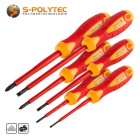 €12.90 / pcs
€12.90 / pcsIncl. 19% Tax
VDE-Wire stripper 1000V
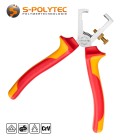 €11.90 / pcs
€11.90 / pcsIncl. 19% Tax
VDE-Diagonal cutters 1000V
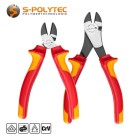 from €11.90 / pcs
from €11.90 / pcsIncl. 19% Tax
VDE-Combination pliers 1000V
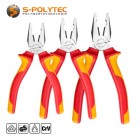 from €11.90 / pcs
from €11.90 / pcsIncl. 19% Tax
VDE needle nose pliers, straight, 1000V
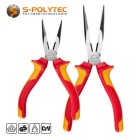 from €12.90 / pcs
from €12.90 / pcsIncl. 19% Tax
VDE bent needle-nose pliers, 1000V
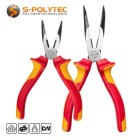 from €12.90 / pcs
from €12.90 / pcsIncl. 19% Tax
Cable stripping tool
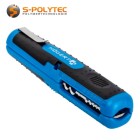 €12.90 / pcs
€12.90 / pcsIncl. 19% Tax
Inductive voltage tester
 €12.50 / pcs
€12.50 / pcsIncl. 19% Tax
Striking line 30m (incl. chalk)
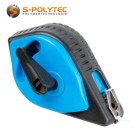 €6.90 / pcs
€6.90 / pcsIncl. 19% Tax
Safety first – with VDE tools!
Power tools and electronic tools – top quality for the highest demands
Side cutters, screwdrivers, combination pliers – tools that are found in every toolbox. But usually only in very simple designs for everyday use. On construction sites for installing domestic electrical systems, in switch cabinet construction or even in specialist repair shops for electrical and electronic devices, such tools are usually not sufficient. In car repair shops, and even in bicycle repair shops, the ever-increasing number of e-bikes means that special power tools are needed that are tailored to the requirements, enable work to be carried out under voltage and ensure professional cable routing and wiring.
We rely on tested quality – for your safety!
With the tools in our shop, we offer a selection of professional-quality tools specifically designed for the electrical industry, skilled trades and the electronics sector. These range from useful tools for easy marking and measuring, to precision screwdrivers for microscopic screws in electronic devices and circuit boards, to special tools for stripping cables. This category is sure to make the hearts of tradespeople beat faster. To ensure that this remains the case, all insulated pliers and screwdrivers are not only GS-tested but also insulated in accordance with VDE standards.
The typical red and yellow handle sleeves not only indicate professional insulation up to 1000 V AC (1500 V DC), but are also much easier to see – a sign of maximum safety. At the same time, the tools impress with their robust steel quality, ergonomic design and, in some cases, versatile functions: such as stripping, crimping or cutting with pliers. All other electrical and electronic tools are also optimally adapted to the tasks at hand. Both in terms of function and material selection, as well as in terms of ease of use. The result is professional tools that meet the highest demands in terms of handling, service life and protection.
- All tools are made from high-quality materials to meet the highest standards
- The power tools and electrical equipment are approved for commercial use
- The insulated pliers and screwdrivers are VDE-tested and marked
- All tools are manufactured in accordance with applicable DIN specifications, where applicable
- The blades of the screwdrivers and pliers are hardened for maximum service life
- Our VDE pliers are available in various sizes and designs
- The precision screwdrivers are supplied in practical storage boxes
- Blade tools for setting down have a locking device or blade guard
- The tools are well designed for ease of use and ergonomically shaped
What is VDE and why is it important?
The inconspicuous abbreviation VDE stands for ‘Verband der Elektrotechnik, Elektronik und Informationstechnik e.V.’ (Association for Electrical, Electronic and Information Technologies), founded in 1893. In Germany, the VDE is centrally responsible for test seals and safety standards in the electrical sector. This applies to both electrical appliances and tools intended for use on electrical appliances. Together with international standards such as IEC 60900, the association specifies the strict requirements for protective insulation tools that are necessary for working with live electrical equipment. This is important because sometimes work under voltage or in the immediate vicinity of live components cannot be avoided. Typical examples include connecting cables to circuit breakers in the house connection box or taking measurements for fault analysis on electrical appliances. Since no one voluntarily accepts the risk of electric shock and thus puts their own life at risk, the strict test criteria that a VDE tool must meet are more than reasonable.
Every tool that is VDE-tested and meets the IEC60900 test criteria is awarded a seal of approval. This is usually placed visibly on the tool, as it reflects the quality of the tool and the professionalism of the manufacturer. There is actually no obligation to do so. However, an insulated tool may only be called a VDE tool or VDE-tested tool if it has undergone and passed the voluntary test. Only then may the test seal be printed on the tool. The voltage range and the IEC standard of the test procedure are also usually specified.
Key test criteria according to IEC60900
- Electrical testing Tools must withstand voltages of up to 10,000 V during testing
- Mechanical load capacity VDE tools must be resistant to bending, pulling, impact and cutting
- Temperature check The insulation must remain secure and firmly attached to the tool even at extreme temperatures
- Ageing test The insulation must not fail at any time, even after prolonged exposure
Typical features of VDE tools
- Strong insulation The handles are usually covered with a slightly thicker layer.
- Two-colour insulation For easier identification in the toolbox
- Wide grip collar For improved protection against contact due to slipping
- High-quality steel High-alloy steel ensures long-lasting resilience
- VDE test seal Not mandatory but a useful quality feature
- GS test mark Usually fulfilled, as less stringent than the VDE criteria
- Strong insulation The handles are usually covered with a slightly thicker layer.
- Two-colour insulation For easier identification in the toolbox
- Wide grip collar For improved protection against contact due to slipping
- High-quality steel High-alloy steel ensures long-lasting resilience
- VDE test seal Not mandatory but a useful quality feature
- GS test mark Usually fulfilled, as less stringent than the VDE criteria
CONCLUSION:
VDE tools are subject to extremely strict criteria and represent the highest safety standards in electrical engineering, even exceeding the requirements of the GS safety mark. However, there is no mandatory testing. If you want to be on the safe side when it comes to insulated pliers and screwdrivers, make sure they bear this quality seal. This quality seal provides protection for tradespeople and electricians, allowing them to work safely on live equipment – provided that the tools are regularly tested and visually inspected for damage.
No VDE certification – what now?
Not all tools typically used in electrical and electronic trades are designed for working with live equipment, but they still belong in every well-stocked toolbox. A VDE test mark is not required on a chalk line or cable sheath cutter and would not make much sense. There are other important features to consider here. Good workmanship, easy handling and, where applicable, compliance with DIN standards should be a matter of course for high-quality tools. The quality seal for tested safety is also one of the outstanding quality features of power tools, but it does not say anything about the protective effect of the insulation; it merely certifies that the tool can be used safely and without risk.
A CE mark, on the other hand, is not a special quality feature. Within the EU, all electrical devices, whether battery-powered or connected to the mains, may only be placed on the market – i.e. sold – if the product complies with the basic safety, health and environmental protection requirements of the European Union (EU). There is no way around this. This applies to our inductive voltage tester, but also to your toaster at home or your 75-inch TV.
Better safe than sorry – use the right tool
It is important that electrical and electronic tools are used exclusively for their intended purpose. Although not all activities pose the same risk of fatal electric shock, damage to equipment and tools can still have unforeseeable consequences. Damage to circuit boards caused by using the wrong screwdriver, broken wires due to notches in the copper cable when setting it down with combination pliers, or cuts in the wire insulation caused by stripping the cable with a cutter knife. This would not have happened with the right professional tools.
If a tool has no or insufficient insulated handles, working on live cables, devices and components is not permitted and is very dangerous. However, tested insulation does not mean that everything can be carried out with the appropriate tool while live. A conventional NYM-J 3.1.5 mm² cable, as used in domestic installations for wiring lamps and sockets, can be cut easily with side cutters. However, if it is live, there will be a short bang – a short circuit. The side cutters will have a thick notch in the cutting surfaces and will no longer be usable – you'll be lucky if that's the only problem and you don't fall off the ladder in shock. But even if the fuse is switched off, cutting through the cable can have consequences, because if the circuit is connected to a residual current circuit breaker (RCCB), it will trip. The problem can be solved by removing a piece of the cable sheathing with the cable sheath cutter where the cable is to be cut and then cutting each individual wire one after the other with the side cutters.
- VDE side cutters For cutting single wires and voltage-free cables
- VDE wire strippers For damage-free stripping of individual cores and wires
- VDE flat-round pliers For precise gripping, guiding, bending, cutting and holding
- VDE combination pliers For more powerful gripping, guiding, bending, cutting and holding
- Cable stripping tool For easy and quick stripping of cable sheaths and individual wires
- Cable jacket cutter For stripping sheathing from cables with larger diameters
- VDE screwdriver For processing screws inside or near live components
- Wire locator For locating concealed live cables in walls, ceilings and floors
- Electronic screwdriver For processing small screws in tension-free electronic devices
CONCLUSION:
A VDE screwdriver is not a chisel and can even damage the insulation if used for purposes other than those intended. Side cutters are also no substitute for wire strippers, as they can damage the cable, which can cause the core to break, especially in rigid copper cables. This can have unforeseeable consequences in junction boxes and distribution boxes. There is a right tool for every task, and when working with electricity, it is particularly important to use tools for their intended purpose in order to prevent damage to the tool or personal injury.
Tips for safe handling of VDE tools
- Work on electrical systems and devices must only be carried out by qualified personnel
- Before starting work, check the tool for damage to the protective insulation and check that it is working properly
- If possible, disconnect from the power supply and secure against being switched back on
- If required in the work area, lay out insulation mats for high voltage
- Only hold and use VDE tools by their protective insulated handles
- Use the insulated tools exclusively for their intended purpose
- Do not leave tools lying around inside electrical equipment after use
WARNING: All these instructions are for your own safety when handling live components, devices and cables. Be attentive and careful when working with live equipment. Take regular breaks if necessary.
Care and storage of insulated tools
Effective protection against electric shock is only as good as the insulation and condition of the tool itself. It is therefore highly recommended to briefly inspect the tool, whether it is a screwdriver or combination pliers, before use. Check whether the insulation shows any external damage and whether the tool itself, for example the tip of the screwdriver, is intact. Damaged gripping and cutting surfaces are also a clear indication that the tool may no longer be adequate for safe and intended use. This brief moment should be worth your own safety.
Cleaning the handles and surfaces occasionally with a damp cloth not only makes the tool look better, but also contributes to its longevity. However, damp or wet tools should never be used on live components or cables. A small drop of thin oil from time to time can keep the joints of pliers tools running smoothly. Excess oil can be removed with a lint-free cloth. There are basically only two things to consider when storing tools. An environment that is too damp is generally not ideal for tools. The insulation is an essential component of the tool and should therefore always be in perfect condition. For storage, it is therefore advisable not to store VDE tools in the same compartment as sharp objects such as scissors, knives or saws.